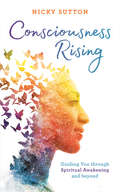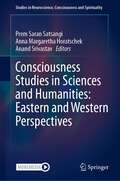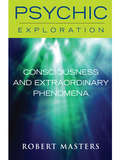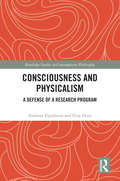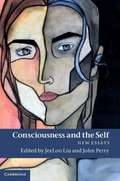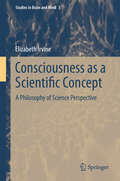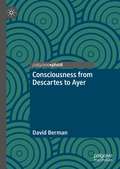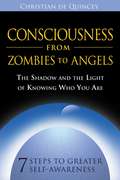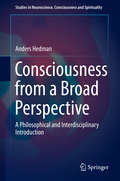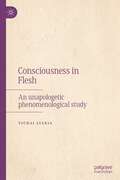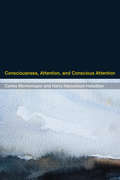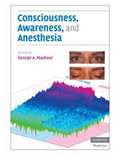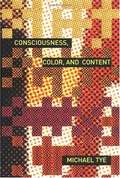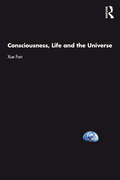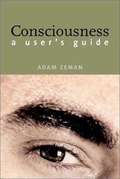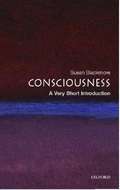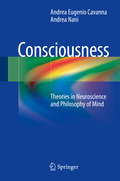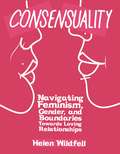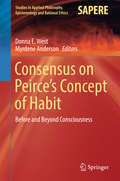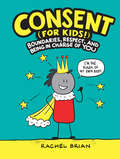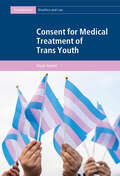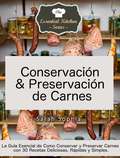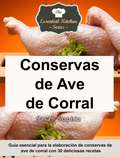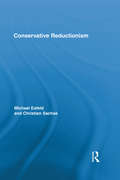- Table View
- List View
Consciousness Rising: Guiding You through Spiritual Awakening and beyond
by Nicky SuttonNicky Sutton offers this transformative guide to spiritual awakening, giving advice on manifesting, meditating and moving through any challenging parts of the journey from awakening to rebirth.A compassionate guide to the process and challenges of spiritual awakening, from breakthrough and enlightenment to finding peace, balance and connection with your higher self.How do you know if you're experiencing a spiritual awakening? If your sense of self is dissolving, or your perceptions of reality and purpose are transforming uncontrollably, then it's possible. Sometimes a significant life event, such as a loss, sudden insight, societal change, or a mystical experience, can cause a spontaneous and unexpected shift within us. Spiritual and meditation guide Nicky Sutton is here to help you navigate the waves of transformation as you awaken to further revelations. In this book she breaks down the stages of spiritual awakening and offers compassionate, practical advice to enhance your journey - including tips for manifesting, meditating, and developing your psychic and intuitive abilities. You are an ever-evolving being on the road to greater understanding, and this powerful and reassuring guide is here to help you rise to the challenge of spiritual awakening and find peace, balance, and connection with your higher self.
Consciousness Studies in Sciences and Humanities: Eastern and Western Perspectives (Studies in Neuroscience, Consciousness and Spirituality #8)
by Anand Srivastav Prem Saran Satsangi Anna Margaretha HoratschekThis book presents consciousness models from Eastern and Western perspectives that accommodate current scientific research in the natural sciences and humanities, from neurological experiments through philosophical enquiries to spiritual approaches. It offers up to date research from key disciplines in consciousness studies ranging from neurology, quantum mechanics, algorithmic science, mathematics, and astrophysics to literary studies, philosophy, and (comparative) theology. The volume examines the dichotomy between Western and Eastern perceptions of consciousness – where consciousness is perceived as brain activity by Western scientists, and as a divine presence by various religions, especially in the East. The essays contextualize each other and reciprocally illuminate the potential and limits of the respective approaches. The texts aim at a transdisciplinary and transcultural exchange of ideas in consciousness studies and address a readership from interested lay-readers to experts of the field. The volume is of interest to researchers of consciousness studies.
Consciousness and Extraordinary Phenomena
by Robert MastersTwo cases are described in which extraordinary phenomena appear to have been elicited within the context of altered states of consciousness (trance) in a laboratory setting. This essay, chapter 26 of Psychic Exploration, studies these two cases. The full volume of Psychic Exploration can be purchased as an ebook or paperback version from all major online retailers and at cosimobooks.com.
Consciousness and Perceptual Experience
by Thomas NatsoulasThis book describes and proposes an unusual integrative approach to human perception that qualifies as both an ecological and a phenomenological approach at the same time. Thomas Natsoulas shows us how our consciousness - in three of six senses of the word that the book identifies - is involved in our activity of perceiving the one and only world that exists, which includes oneself as a proper part of it, and that all of us share together with the rest of life on earth. He makes the case that our stream of consciousness - in the original Jamesian sense minus his mental/physical dualism - provides us with firsthand contact with the world, as opposed to our having such contact instead with theorist-posited items such as inner mental representations, internal pictures, or sense-image models, pure figments and virtual objects, none of which can have effects on our sensory receptors.
Consciousness and Physicalism: A Defense of a Research Program (Routledge Studies in Contemporary Philosophy)
by Andreas Elpidorou Guy DoveConsciousness and Physicalism: A Defense of a Research Program explores the nature of consciousness and its place in the world, offering a revisionist account of what it means to say that consciousness is nothing over and above the physical. By synthesizing work in the philosophy of mind, metaphysics, and philosophy of science from the last twenty years and forging a dialogue with contemporary research in the empirical sciences of the mind, Andreas Elpidorou and Guy Dove advance and defend a novel formulation of physicalism. Although physicalism has been traditionally understood to be a metaphysical thesis, Elpidorou and Dove argue that there is an alternative and indeed preferable understanding of physicalism that both renders physicalism a scientifically informed explanatory project and allows us to make important progress in addressing the ontological problem of consciousness. Physicalism, Elpidorou and Dove hold, is best viewed not as a thesis (metaphysical or otherwise) but as an interdisciplinary research program that aims to compositionally explain all natural phenomena that are central to our understanding of our place in nature. Consciousness and Physicalism is replete with philosophical arguments and informed, through and through, by findings in many areas of scientific research. It advances the debate regarding the ontological status of consciousness. It will interest students and scholars in philosophy of mind, metaphysics, philosophy of cognitive science, and philosophy of science. And it will challenge both foes and friends of physicalism.
Consciousness and the Self
by John Perry Jeeloo Liu'I never can catch myself at any time without a perception, and never can observe any thing but the perception.' These famous words of David Hume, on his inability to perceive the self, set the stage for JeeLoo Liu and John Perry's collection of essays on self-awareness and self-knowledge. This volume connects recent scientific studies on consciousness with the traditional issues about the self explored by Descartes, Locke and Hume. Experts in the field offer contrasting perspectives on matters such as the relation between consciousness and self-awareness, the notion of personhood and the epistemic access to one's own thoughts, desires or attitudes. The volume will be of interest to philosophers, psychologists, neuroscientists, cognitive scientists and others working on the central topics of consciousness and the self.
Consciousness as a Scientific Concept: A Philosophy of Science Perspective (Studies in Brain and Mind #5)
by Elizabeth IrvineThe source of endless speculation and public curiosity, our scientific quest for the origins of human consciousness has expanded along with the technical capabilities of science itself and remains one of the key topics able to fire public as much as academic interest. Yet many problematic issues, identified in this important new book, remain unresolved. Focusing on a series of methodological difficulties swirling around consciousness research, the contributors to this volume suggest that 'consciousness' is, in fact, not a wholly viable scientific concept. Supporting this 'eliminativist' stance are assessments of the current theories and methods of consciousness science in their own terms, as well as applications of good scientific practice criteria from the philosophy of science. For example, the work identifies the central problem of the misuse of qualitative difference and dissociation paradigms, often deployed to identify measures of consciousness. It also examines the difficulties that attend the wide range of experimental protocols used to operationalise consciousness--and the implications this has on the findings of integrative approaches across behavioural and neurophysiological research. The work also explores the significant mismatch between the common intuitions about the content of consciousness, that motivate much of the current science, and the actual properties of the neural processes underlying sensory and cognitive phenomena. Even as it makes the negative eliminativist case, the strong empirical grounding in this volume also allows positive characterisations to be made about the products of the current science of consciousness, facilitating a re-identification of target phenomena and valid research questions for the mind sciences.
Consciousness from Descartes to Ayer
by David BermanThe title is meant to indicate that consciousness is being examined largely within the history of philosophy, and within the period of time from Descartes to Ayer. Investigators aiming to understand consciousness and minds usually try to take account of all individual human minds, so as to have the most data for the most encompassing induction. The problem with that approach is that because of the vastness of the data, its results tend to be vague, lacking the specificity of studies of individuals. On the other hand, the problem with studies of individuals is that they cannot guarantee generality, as the opposing method can. This book's distinctive approach aims at a middle way, getting the best of the two opposing methods by drawing its data from the history of philosophy, especially the history of the great philosophers.
Consciousness from Zombies to Angels: The Shadow and the Light of Knowing Who You Are
by Christian De QuinceyA user-friendly, step-by-step guide to understanding the mind• Presents a practical journey into understanding consciousness--philosophy’s hardest problem, science’s final frontier, and spirituality’s deepest mystery• Offers 7 steps to transform your life using the shadow and the light of consciousnessConsciousness from Zombies to Angels presents a practical, step-by-step “owner’s guide” for the mind that sorts out philosophy’s hardest problem, science’s final frontier, and spirituality’s deepest mystery--what consciousness is, how it works, and why it’s important. Christian de Quincey presents seven simple steps for understanding consciousness and how it can lead to spiritual awareness: observe your language, identify the problem, learn how to look, recognize your patterns, know yourself, embrace your shadow, and practice transformation.All of us exhibit both shadow and light, aspects of ourselves we fear and deny (our inner Zombies) as well as qualities we admire and want to radiate (our inner Angels). The key to a creative and fulfilled life is to integrate both. De Quincey reveals that the way to transformation is to accept ourselves exactly as we are--a work in progress.Readers will learn the difference between “energy talk” and “consciousness talk”; how the body affects the mind, and vice versa; and where to go for help to develop consciousness, heal emotions, or grow spiritually. De Quincey shows how to recognize and break habits and patterns that run your life, how to find out who you really are, and why facing up to your darkest fears will liberate your brightest light as you learn to embrace all of your humanity and experience the power of transformation.
Consciousness from a Broad Perspective: A Philosophical and Interdisciplinary Introduction (Studies in Neuroscience, Consciousness and Spirituality #6)
by Anders HedmanThis volume offers an introduction to consciousness research within philosophy, psychology and neuroscience, from a philosophical perspective and with an emphasis on the history of ideas and core concepts. The book begins by examining consciousness as a modern mystery. Thereafter, the book introduces philosophy of mind and the mind-body problem, and proceeds to explore psychological, philosophical and neuroscientific approaches to mind and consciousness. The book then presents a discussion of mysterianist views of consciousness in response to what can be perceived as insurmountable scientific challenges to the problem of consciousness. As a response to mysterianist views, the next chapters examine radical approaches to rethinking the problem of consciousness, including externalist approaches. The final two chapters present the author's personal view of the problem of consciousness. Consciousness remains a mystery for contemporary science--a mystery raising many questions. Why does consciousness persist as a mystery? Are we humans not intelligent enough to solve the riddle of consciousness? If we can solve this mystery, what would it take? What research would we need to conduct? Moreover, the mystery of consciousness prompts the larger question of how well the cognitive sciences have actually advanced our understanding of ourselves as human beings. After all, consciousness is not just a minor part of our existence. Without consciousness, we would not be human beings at all. This book aims to increase the accessibility of major ideas in the field of consciousness research and to inspire readers to contribute to the ongoing discussion of the place of consciousness in nature.
Consciousness in Flesh: An Unapologetic Phenomenological Study
by Yochai AtariaThis book offers an uncompromising and unapologetic phenomenological study of altered states of consciousness in an attempt to understand the structure of human consciousness. Drawing on the philosophy of Merleau-Ponty, it sets out to decipher the inextricable link between consciousness, body, and world. This link will be established through the presentation of in-depth phenomenological research conducted with former prisoners of war (POWs) and senior meditators. Focusing on two such disparate groups improves our understanding of the nature of the subjective experience in extreme situations – when our sense of boundary is rigid and we are disconnected both from the body and the world (POWs); and when our sense of boundary is fluid and we feel unified with the world (meditators). Based on empirical-phenomenological research, this book will explain how the body that is from the outset thrown into the intersubjective world shapes the structure of consciousness.
Consciousness, Attention, and Conscious Attention (The\mit Press Ser.)
by Carlos Montemayor Harry Haroutioun HaladjianA rigorous analysis of current empirical and theoretical work supporting the argument that consciousness and attention are largely dissociated.In this book, Carlos Montemayor and Harry Haladjian consider the relationship between consciousness and attention. The cognitive mechanism of attention has often been compared to consciousness, because attention and consciousness appear to share similar qualities. But, Montemayor and Haladjian point out, attention is defined functionally, whereas consciousness is generally defined in terms of its phenomenal character without a clear functional purpose. They offer new insights and proposals about how best to understand and study the relationship between consciousness and attention by examining their functional aspects. The book's ultimate conclusion is that consciousness and attention are largely dissociated. Undertaking a rigorous analysis of current empirical and theoretical work on attention and consciousness, Montemayor and Haladjian propose a spectrum of dissociation—a framework that identifies the levels of dissociation between consciousness and attention—ranging from identity to full dissociation. They argue that conscious attention, the focusing of attention on the contents of awareness, is constituted by overlapping but distinct processes of consciousness and attention. Conscious attention, they claim, evolved after the basic forms of attention, increasing access to the richest kinds of cognitive contents.Montemayor and Haladjian's goal is to help unify the study of consciousness and attention across the disciplines. A focused examination of conscious attention will, they believe, enable theoretical progress that will further our understanding of the human mind.
Consciousness, Awareness, and Anesthesia
by George A. MashourHypnosis, amnesia, and immobility are three major therapeutic endpoints of general anesthesia. In one to two cases out of a thousand, hypnosis and amnesia are not achieved - often leaving a patient immobile but capable of experiencing and remembering intraoperative events. Awareness during general anesthesia is one of the most dreaded complications of surgery and is feared by patients and clinicians alike. Despite many advances in the field, there are also a number of unresolved questions that persist. Some of the difficulties in the detection and prevention of awareness during anesthesia relate to the underlying complexities of the neuroscientific basis of consciousness. Consciousness, Awareness, and Anesthesia is a multidisciplinary approach to both the scientific problem of consciousness and the clinical problem of awareness during general anesthesia. An international cadre of authors with expertise in anesthesiology, neurobiology, and philosophy provides a cutting-edge perspective. No other book on the subject has drawn from such a breadth of scholarship.
Consciousness, Color, and Content
by Michael TyeExperiences and feelings are inherently conscious states. There is something it is like to feel pain, to have an itch, to experience bright red. Philosophers call this sort of consciousness "phenomenal consciousness."
Consciousness, Life and the Universe
by Xue FanWhat is consciousness? What is life? What is the universe? This book explores these three interconnected questions, providing deep insights into the past, present and future of consciousness research. Consciousness, Life and the Universe builds a unified view of consciousness across biological, chemical and physical scales, tracing the natural connections from the infinitesimally small to the infinitely big; from quantum fields and elementary particles to molecules, cells and living organisms to the cosmos; from the evolution of life to the evolution of the universe and to the future of humanity. The book provides a unified framework for future consciousness studies and identifies the scientific and technological approaches that are essential for further understanding consciousness. Through this pioneering research approach, the book clearly redefines consciousness and life and conceives a plausible view of the origin and nature of the universe. This is a must-read for students and researchers in consciousness studies, cognitive psychology, cognitive science and neuroscience, as well as anyone interested in the biological and physical basis of consciousness and the history and evolution of consciousness research.
Consciousness: A User's Guide
by Adam ZemanThis engaging and readable book provides an introduction to consciousness that does justice both to the science and to the philosophy of consciousness, that is, the mechanics of the mind and the experience of awareness. The book opens with a general discussion of the brain and of consciousness itself. Then, exploring the areas of brain science most likely to illuminate the basis of awareness, Zeman focuses on the science of sleep and waking and on the science of vision. He describes healthy states and disorders--epilepsy, narcolepsy, blindsight and hallucinations after stroke--that provide insights into the capacity for consciousness and into its contents. And he tracks the evolution of the brain, the human species, and human culture and surveys the main current scientific theories of awareness, pioneering attempts to explain how the brain gives rise to experience. Zeman concludes by examining philosophical arguments about the nature of consciousness. A practicing neurologist, he animates his text with examples from the behavioral and neurological disorders of his patients and from the expanding mental worlds of young children, including his own. His book is an accessible and enlightening explanation of why we are conscious.
Consciousness: A Very Short Introduction
by Susan Blackmore"The last great mystery for science," consciousness has become a controversial topic. Consciousness: A Very Short Introduction challenges readers to reconsider key concepts such as personality, free will, and the soul. How can a physical brain create our experience of the world? What creates our identity? Do we really have free will? Could consciousness itself be an illusion? Exciting new developments in brain science are opening up these debates, and the field has now expanded to include biologists, neuroscientists, psychologists, and philosophers. This book clarifies the potentially confusing arguments and clearly describes the major theories, with illustrations and lively cartoons to help explain the experiments. Topics include vision and attention, theories of self, experiments on action and awareness, altered states of consciousness, and the effects of brain damage and drugs. This lively, engaging, and authoritative book provides a clear overview of the subject that combines the perspectives of philosophy, psychology, and neuroscience--and serves as a much-needed launch pad for further exploration of this complicated and unsolved issue.
Consciousness: Theories in Neuroscience and Philosophy of Mind
by Andrea Eugenio Cavanna Andrea NaniThis book reviews some of the most important scientific and philosophical theories concerning the nature of mind and consciousness. Current theories on the mind-body problem and the neural correlates of consciousness are presented through a series of biographical sketches of the most influential thinkers across the fields of philosophy of mind, psychology and neuroscience. The book is divided into two parts: the first is dedicated to philosophers of mind and the second, to neuroscientists/experimental psychologists. Each part comprises twenty short chapters, with each chapter being dedicated to one author. A brief introduction is given on his or her life and most important works and influences. The most influential theory/ies developed by each author are then carefully explained and examined with the aim of scrutinizing the strengths and weaknesses of the different approaches to the nature of consciousness.
Consensuality
by Helen WindfellThere are infinite possibilities in human relationships, but the fairytale ideal of companionship does not exist for most people. In Consensuality, Helen Wildfell and her co-adventurers detail the process for creating or finding a healthy, successful relationship as well as common pitfalls and how to avoid them, like gender identity, sexual boundaries, power struggles, and emotional dysfunction. Overcoming regret and resentment, the authors describe a journey towards a respectful social environment. Their experiences lead to lessons of self-empowerment and communication tips for building healthy partnerships. We recognize their preferences and boundaries. We discuss how those fit with our own preferences and boundaries. Filled with personal descriptions of the complex layers in human interaction, the book combines gender studies with memoir to truly make the personal political.
Consensus on Peirce’s Concept of Habit: Before and Beyond Consciousness (Studies in Applied Philosophy, Epistemology and Rational Ethics #31)
by Donna E. West Myrdene AndersonThis book constitutes the first treatment of C. S. Peirce s unique concept of habit. Habit animated the pragmatists of the 19th and early 20th centuries, who picked up the baton from classical scholars, principally Aristotle. Most prominent among the pragmatists thereafter is Charles Sanders Peirce. In our vernacular, habit connotes a pattern of conduct. Nonetheless, Peirce s concept transcends application to mere regularity or to human conduct; it extends into natural and social phenomena, making cohesive inner and outer worlds. Chapters in this anthology define and amplify Peircean habit; as such, they highlight the dialectic between doubt and belief. Doubt destabilizes habit, leaving open the possibility for new beliefs in the form of habit-change; and without habit-change, the regularity would fall short of habit conforming to automatic/mechanistic systems. This treatment of habit showcases how, through human agency, innovative regularities of behavior and thought advance the process of making the unconscious conscious. The latter materializes when affordances (invariant habits of physical phenomena) form the basis for modifications in action schemas and modes of reasoning. Further, the book charts how indexical signs in language and action are pivotal in establishing attentional patterns; and how these habits accommodate novel orientations within event templates. It is intended for those interested in Peirce s metaphysic or semiotic, including both senior scholars and students of philosophy and religion, psychology, sociology and anthropology, as well as mathematics, and the natural sciences. "
Consent (for Kids!): Boundaries, Respect, and Being in Charge of YOU
by Rachel Brianp.p1 {margin: 0.0px 0.0px 0.0px 0.0px; font: 12.0px Times} p.p2 {margin: 0.0px 0.0px 0.0px 0.0px; font: 12.0px Times; min-height: 14.0px} With clear explanations, fun illustrations, and expertly-presented information, Consent (for Kids!) is an empowering introduction to consent, bodily autonomy, and how to respect yourself and others. Consent is like being ruler of your own country...population: YOU. This is a smart, playful guide to consent and bodily autonomy, packed with bright and energetic illustrations. Readers will learn about boundaries and how to set them; ways to respect themselves and others; what to do if someone makes them feel uncomfortable or unsafe; and much more. Along the way, they'll be encouraged to reflect on (and improve!) their own behavior and to practice consent in their daily lives. Whether you're looking for a consent primer to share with a friend or searching for a way to talk to your child about what it means to be in control of their own body and respect others', look no further! This humorous and insightful book from the co-creator of the viral "Tea Consent" video is the perfect teaching tool, conversation starter, and insightful, empowering resource for educators, kids, and families everywhere.
Consent for Medical Treatment of Trans Youth (Cambridge Bioethics and Law)
by Steph JowettAccess to medical treatment for trans youth occupies a haphazard and dynamic legal landscape. In this comprehensive scholarly analysis of the historical and current legal principles, Steph Jowett examines the medico-legal nexus of regulation of this healthcare in Australia and in England and Wales. This is informed by an in-depth discussion of the medical literature on treatment for trans youth, including clinical guidelines, the outcomes of treatment and outcomes for trans youth who are unable to be treated. With illustrative examples and clear language, Jowett argues that legal barriers to clinical practice should be congruent with and reflect the current state of medical knowledge. Not only does Jowett assess the extent to which key legal decisions have been consistent with medical knowledge in the past, but she offers a nuanced, comparative perspective that will inform reform efforts in the future.
Conservación & Preservación de Carnes
by Sarah Sophia Irene SaraviaLa Guía Esencial de Como Conservar y Preservar Carnes con 30 Recetas Deliciosas, Rápidas y Simples. Conservar y Preservar Carnes, Recetas ¿Estas tratando de encontrar las mejores maneras de enfrascar y preservar carne? ¿Estás buscando por una mejor manera de tener carnes deliciosamente envejecidas y perfectamente tiernas? Bien, amaras el libro de cocina Conservación y Preservación de Carnes. Las recetas contenidas te ofrecerán deliciosas comidas y con un sabor maravilloso que tienen un mejor sabor del que tendrían si no la hubieras conservado y preservado. Tu fácilmente puedes incrementar el tiempo de conservación de tu comida. Tus comidas tendrán un sabor delicioso y te darán un mejor sabor del que imaginaste. En este libro aprenderás: Que es conservación y preservación Como puedes preservar tu comida Porque hace que tu comida tenga un mejor sabor Asombrosas recetas para conservar carnes ¡Y mucho, mucho más! Pero no solo eso, también obtendrás los dos ingredientes que son esenciales para explotar el sabor. Así que, deja de hervir la comida y perder enormes cantidades de sabor y compra el mejor libro disponible en Conservación y Preservación. Tú lo amaras, y tú nunca conservaras de la misma manera otra vez Toma tu copia de Recetas de Conservación y Preservación de Carnes, haciendo un clic en el botón de comprar. Posdata: No olvides tomar el maravilloso regalo gratis dentro de este libro, es solo nuestra manera de decir “Gracias por comprar” Un libro de La Serie Esencial de Cocina – Revísanos en Facebook.
Conservas de Ave de Corral - Guía esencial para la elaboración de conservas de ave de corral con 30 deliciosas recetas
by Belén Garrido Sarah SophiaElaboración de conservas de ave de corral La serie de la cocina esencial, libro 50 ¿Elaborar conservas? ¿No es esto algo que hacía mi abuela? Lo es, y este informativo libro de recetas desvela las razones. La elaboración de conservas, que en sus orígenes empezó como una manera de ahorrar dinero y alargar la vida útil de los alimentos, ha adquirido un significado completamente nuevo en nuestros tiempos modernos. En particular, las aves de corral son muy versátiles y están cargadas de nutrientes y sabores potenciales. Aprenda a extraer esas gemas ocultas a base de seguir estas pautas y recetas. Prepare deliciosas y apetecibles conservas y después hágaselas degustar a sus amigos y seres queridos. ¿Un arte perdido? ¡Ya no! Créame, elaborar conservas de ave de corral va mucho más allá de meter unos cuantos muslos de pollo en un tarro de cristal y poner la tapa. Es un arte que requiere unos pasos precisos y seguros para producir los mejores productos alimenticios. Se trata de añadir especias, adobos y otras ideas para potenciar el sabor a la mezcla y disfrutarla meses después. Cualquier combinación sabrosa es posible. Una vez que domine las 30 deliciosas recetas incluidas en este sencillo libro de cocina, sorprenderá a su familia y sus amigos con sus propias mezclas. Es imposible que estas maravillosas recetas le fallen. Es fácil y divertido. En las páginas de este práctico libro de cocina lo abarcamos todo: qué es la elaboración de conservas - cómo funciona, el método en sí y una variedad realista de maravillosas recetas. Aprenda lo que miles de personas ya han descubierto: elaborar conservas de alimentos es gratificante y económico - sorprenda a sus amigos y después dígales dónde ha encontrado esta joya de libro cocina. Si se lo puede comer... lo puede envasar. Esta instructiva guía práctica con recetas es el único recurso que va a necesita
Conservative Reductionism (Routledge Studies in the Philosophy of Science)
by Christian Sachse Michael EsfeldConservative Reductionism sets out a new theory of the relationship between physics and the special sciences within the framework of functionalism. It argues that it is wrong-headed to conceive an opposition between functional and physical properties (or functional and physical descriptions, respectively) and to build an anti-reductionist argument on multiple realization. By contrast, (a) all properties that there are in the world, including the physical ones, are functional properties in the sense of being causal properties, and (b) all true descriptions (laws, theories) that the special sciences propose can in principle be reduced to physical descriptions (laws, theories) by means of functional reduction, despite multiple realization. The book develops arguments for (a) from the metaphysics of properties and the philosophy of physics. These arguments lead to a conservative ontological reductionism. It then develops functional reduction into a fully-fledged, conservative theory reduction by means of introducing functional sub-types that are coextensive with physical types, illustrating that conservative reductionism by means of case studies from biology (notably the relationship between classical and molecular genetics).
